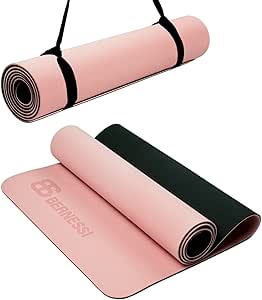Introduction

If you’ve ever tried practicing yoga on a carpet, you already know it’s not the most stable surface. The carpet feels soft and cozy under your feet, but when it comes to yoga, it can cause issues like slipping, sinking, or losing balance during poses. That’s where the right yoga mat for carpet makes all the difference.
Unlike hardwood or tiled floors, carpet requires a mat that offers excellent grip, stability, and durability. A standard yoga mat might shift, bunch up, or fail to provide the support you need. Choosing the right one ensures not only comfort but also safety in your practice.
In this guide, we’ll break down everything you need to know about selecting the best yoga mat for carpeted floors—from grip and thickness to materials and user feedback. By the end, you’ll know exactly what to look for and which mats stand out as the best choices.
Grip & Non-Slip Performance
One of the biggest concerns when practicing yoga on carpet is slippage. Even though carpet provides friction, many mats tend to slide around because the fibers underneath can create uneven movement. That’s why the best yoga mat for carpet is one designed with superior grip.
A good yoga mat should have:
- Textured surfaces: These prevent slipping during poses like downward dog or warrior.
- Anti-slip coating: Helps keep the mat firmly in place even on softer carpets.
- Dual-layer grip: Some mats are designed with a sticky bottom to cling to carpet fibers while offering a non-slip surface on top.
Without proper grip, you’ll constantly be adjusting your mat instead of focusing on your practice. This can break your flow and even lead to injuries if you slip in the middle of a pose.
If you practice hot yoga or sweat a lot, grip becomes even more important. Sweat can make mats slippery, but certain materials like natural rubber or mats with moisture-absorbing properties provide extra traction.
Thickness & Cushioning
Practicing yoga on carpet already provides some padding, but that doesn’t mean any mat will work. In fact, the thickness of your yoga mat is one of the most crucial factors to consider.
- Thin mats (3mm–4mm): Great for stability and balance, but they might feel uncomfortable if your carpet is already soft and plush. Thin mats are best if your carpet is low-pile or firm.
- Medium thickness mats (5mm–6mm): These are ideal for carpet because they balance comfort and stability. You won’t sink too deep, and your joints still get decent cushioning.
- Thick mats (8mm–10mm+): While extra cushioning sounds nice, thick mats can actually reduce balance on carpet. They may feel spongy and unstable, making poses harder to hold.
The key is finding a balance. Since carpets already have give, most yogis prefer mats between 5mm and 6mm for carpeted practice spaces. This allows enough stability without sacrificing comfort for the knees and wrists
